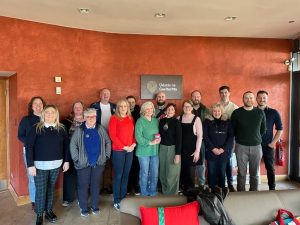
Gàidheil and Gaeilge Leading in Cultural Tourism success
We recently delivered the ‘Gàidheil and Gaeilge Leading in Cultural Tourism’ across two residentials in Spring 2023 with support from Bòrd na Gàidhlig and Údarás na Gaeltachta. The programme helped leaders in community-based organisations – in both Scotland & Ireland – to understand the rapidly changing nature of tourism and tourists.
About 1,500 years ago the Scots left Ireland for Argyll and took their language with them. Over the last millennia and a half, Irish and Scots Gaelic has diverged a bit, but Gaelic is still one language and culturally the Gaels are one people. Celebrating identity and building cultural tourism is more difficult across nation-state boundaries, but tourists see people and places with much in common, not lines on a map.
With support from Bòrd na Gàidhlig and Údarás na Gaeltachta, the Academy delivered the ‘Gàidheil and Gaeilge Leading in Cultural Tourism’ across two residentials in Spring 2023. The programme helped leaders in community-based organisations – in both Scotland & Ireland – to understand the rapidly changing nature of tourism and tourists. It also emphasised the critical role they can play in the development of the tourism sector in their destination and ensure that tourism celebrates and contributes to their culture. The first residential took place in Galway and the second was held on the Isle of Skye. This provided the 16 participants with the opportunity to experience each other’s Gaelic-speaking communities and explore how the similarities and differences between the two cultures affect the cultural tourism sector in their respective countries.

Throughout the two residential events, learners visited examples of good practices in cultural tourism, from the seaweed factory in Connemara which uses locally sourced materials and the surrounding landscape and culture to produce and promote their range of products and services, to the crofter in Skye who uses AirBnB to reach tourists with his offer of a truly authentic sheepdog training exercise. These were followed by peer-to-peer tasks and informal conversations which enabled learners to reflect on how the visits affected them in their respective contexts. Once the programme had concluded, participants said that these experiences gave them hope for the future and positively changed their perceptions in terms of cultural tourism in relation to Gaelic (in Scotland and Ireland).
Although ‘Gàidheil and Gaeilge Leading in Cultural Tourism’ formally ended several months ago, participants still keep in touch through a WhatsApp group which is constantly buzzing with relevant updates, news, events, thoughts and questions. The group dynamics have been so strong that on an individual level, several learners have independently arranged site visits to some of the cultural tourism attractions which other participants lead, on both sides of the Irish Sea. This is reminiscent of how the Scottish Community Tourism Network (SCOTO) was founded when participants from one cohort of our ‘Communities Leading in Tourism’ programme recognised the synergy involved in collectively working together to achieve tourism-related objectives. SCOTO are going from strength to strength and are growing exponentially.
At the end of the programme, participants summed up their experiences as ‘inspiring’, ‘cultural’ and ‘dynamic’. We look forward to building on this success with more collaborative and cross-cultural programmes in the near future!

